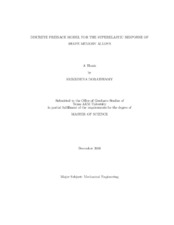| dc.description.abstract | The aim of this work is to present a model for the superelastic response of Shape
Memory Alloys (SMAs) by developing a Preisach Model with thermodynamics basis.
The special features of SMA superelastic response is useful in a variety of applications
(eg. seismic dampers and arterial stents). For example, under seismic loads the SMA
dampers undergo rapid loading{unloading cycles, thus going through a number of
internal hysteresis loops, which are responsible for dissipating the vibration energy.
Therefore the design for such applications requires the ability to predict the response,
particularly internal loops. It is thus intended to develop a model for the superelastic
response which is simple, computationally fast and can predict internal loops. The
key idea here is to separate the elastic response of SMAs from the dissipative response
and apply a Preisach Model to the dissipative response as opposed to the popular
notion of applying the Preisach Model to the stress{strain response directly. Such a
separation allows for the better prediction of internal hysteresis, avoids issues due to
at/negative slopes in the stress{strain plot, and shows good match with experimental
data, even when minimal input is given to the model.
The model is developed from a Gibbs Potential, which allows us to compute a
driving force for the underlying phase transformation in the superelastic response.
The hysteresis between the driving force for transformation and the extent of transformation
(volume fraction of martensite) is then used with a Preisach model. The Preisach model parameters are identi ed using a least squares approach. ASTM
Standards for the testing of NiTi wires (F2516-07^sigma 2), are used for the identi cation of
the parameters in the Gibbs Potential. The simulations are run using MATLAB R
.
Results under di erent input conditions are discussed. It is shown that the predicted
response shows good agreement with the experimental data. A couple of attempts at
extending the model to bending and more complex response of SMAs is also discussed. | en |


